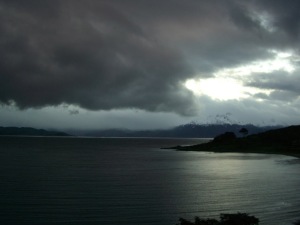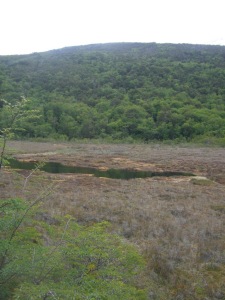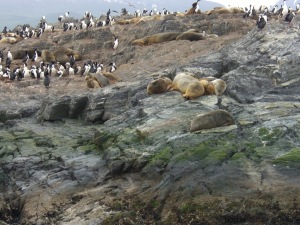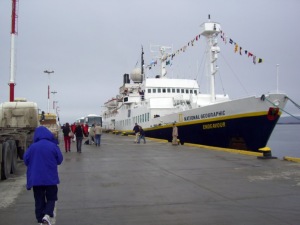 Odd weather is a constant in Ushuaia, Arg.
Odd weather is a constant in Ushuaia, Arg.
The rooms are smaller than my car, and like my Ford Escape, I can get all my luggage in if I pile it up in a pyramid. Everything has to be battened down and the bathroom has fences at the ends of the shelves so toilet accessories won’t fall off. We’ll spend the next two days getting there, to wherever it is we are going first, and dealing with the effects of the seas.
 Before reaching our ship, the group was loaded onto three buses for an hour crawl down mud roads to what really is the end of the world – the end of the Pan-American Highway which runs from La Tierra del Fuego National Park up to Alaska. At both ends of this great highway (which is known for its robbers) the roads are muddy. But 18,000 kilometers or so could be quite a challenge by bicycle or car. Incidentally, Magellan came up with the name Tierra del Fuego because when he arrived here he saw fires all over the place which the Yamana Indians used for warmth (remember they basically lived naked). There are many fire legends – that the islands were erupting volcanoes or that dragons raged on the mountains.
Before reaching our ship, the group was loaded onto three buses for an hour crawl down mud roads to what really is the end of the world – the end of the Pan-American Highway which runs from La Tierra del Fuego National Park up to Alaska. At both ends of this great highway (which is known for its robbers) the roads are muddy. But 18,000 kilometers or so could be quite a challenge by bicycle or car. Incidentally, Magellan came up with the name Tierra del Fuego because when he arrived here he saw fires all over the place which the Yamana Indians used for warmth (remember they basically lived naked). There are many fire legends – that the islands were erupting volcanoes or that dragons raged on the mountains.
In Tierra del Fuego, at this southern end, we learned there are only three kinds of trees – high deciduous beech tree, low deciduous beech tree (darker leafed) and the evergreen beech tree. (Note original names). None have escaped a terrible virus that forms balls on the trees and emits an orange flower called “Indian Bread” which the Yamanas could eat, but no one else. (The only other food Yamanas ate were sea lions.) The trees are also hung with huge balls of light green mistletoe, an imitation of our Christmas decoration, but this one sucks sap out of trees.  Peat Bogs with Spaghum Moss
Peat Bogs with Spaghum Moss
Also in the park are peat bogs covered in red moss but which are being destroyed by an uncontrolable expansion of beavers and rabbits originally brought here by settlers wanting to start a fur industry. Within 60 years, 20 beavers have grown to 100.000 and the beasts are destroying not only the forest but the environmental balance. Hunters are allowed to kill the beavers and rabbits, but they reproduce so rapidly and have no predator, so the important forest is becoming a wasteland of dead tree trunks.
At the road’s end, we boarded a catamaran to sail back to Ushuaia’s port where the National Geographic Endeavor waited for us to board, the buses having arrived with our bags, which were already in our rooms. En route, we closed in on an island covered in cormorants and fat, fuzzy seals that had no interest in our camera lenses. 
*******************
It’s 5 a.m. on Drake Passage, the roughest waters in the world. One wonders if one should have come here after riding the bronco all night. No, I don’t get sea sick. Yes. The waves are high. And it’s gray, rainy, and waves are pushing us around like a candy wrapper in the wind. I worry about losing my exercise routine although maintaining balance is no easy task. There is a small gym with a treadmill we can use “if weather permits.” There is a stretch class this morn at 8. “If weather permits.” Today, the day before Thanksgiving, we are listening to lectures and getting our sea legs – I might add sea heart. Although most of the guests are American, I don’t anticipate a turkey and trimmings meal tomorrow, when we expect to anchor down on Antarctica Peninsula, but just in case, I donated a jar of sage and of poultry seasoning to the chef last night and pray for stuffing.

